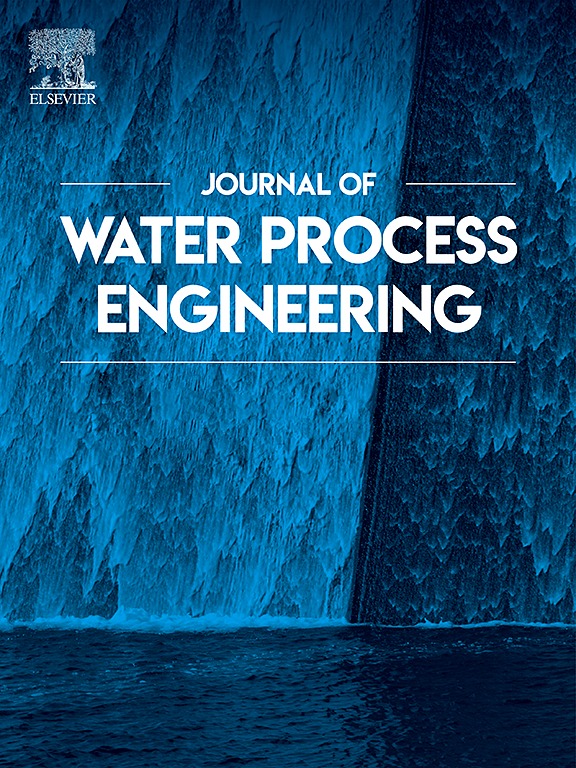Bioremediation of toxic selenium from aqueous solution using Bacillus selenatarsenatis 9470T and machine learning approach
IF 6.3
2区 工程技术
Q1 ENGINEERING, CHEMICAL
引用次数: 0
Abstract
The study focuses on a comprehensive study of the removal of selenium from an aqueous solution using Bacillus selenatarsenatis 9470T and developing a predictive model under laboratory conditions. The growth rate and removal efficiency of the bacterium were investigated by varying pH, incubation time, inoculum dosages, and temperature. The characterization of Bacillus selenatarsenatis 9470T before and after selenium exposure was performed using SEM, EDX, FT-IR, pHzpc, and BET surface area. At 37 °C, the bacterium removed ∼99 % of selenium from the broth with initial concentrations below 10 Se-mg/L at pH 6 and 4 % inoculum dose within 20 h. The pHzpc of Bacillus selenatarsenatis 9470T was 7, and the specific surface area, average pore diameter, and pore volume were found to be 4.309 m2/g, 7.1 nm, and 7.6×10−9 m3/g, respectively, indicating the presence of mesopores. Langmuir isotherm and pseudo-second-order fit well, indicating monolayer sorption and chemisorption, respectively. The Regression Learner tool shows the best fit for Gaussian Process Regression (GPR), followed by Neural Network (NN), Support Vector Machines (SVM), and Tree (T). The best-fitted model (GPR) used for predicting unknown data points gave similar results to those given by the experiment. The study with competing ions affected Se removal efficiency as follows: manganese > iron > zinc > aluminum. The investigation showed that 89.7 % and 85 % of selenium were removed from sump 1 and sump 2, respectively. Moreover, it showed the ability to neutralize and remove other pollutants such as Fe, Mn, Zn, and Mg from real mine water samples. The experiment showed that this bacterium could be utilized to develop a sustainable approach for treating selenium-contaminated wastewater.

本研究的重点是在实验室条件下,利用硒酸芽孢杆菌 9470T 对水溶液中硒的去除进行全面研究,并建立一个预测模型。通过改变 pH 值、培养时间、接种量和温度,研究了该细菌的生长速度和去除效率。使用扫描电镜、EDX、傅立叶变换红外光谱、pHzpc 和 BET 表面积对硒暴露前后的硒酸芽孢杆菌 9470T 进行了表征。在 37 °C、pH 值为 6、接种量为 4 % 的条件下,该细菌在 20 小时内从初始浓度低于 10 Se-mg/L 的肉汤中去除了 ~99 % 的硒。硒亚硒酸芽孢杆菌 9470T 的 pHzpc 值为 7,比表面积、平均孔径和孔体积分别为 4.309 m2/g、7.1 nm 和 7.6×10-9 m3/g,表明存在介孔。朗缪尔等温线和伪二阶拟合良好,分别表明存在单层吸附和化学吸附。回归学习工具显示高斯过程回归(GPR)的拟合效果最好,其次是神经网络(NN)、支持向量机(SVM)和树(T)。用于预测未知数据点的最佳拟合模型(GPR)与实验结果相似。竞争离子对 Se 去除效率的影响如下:锰、铁、锌、铝。调查显示,污水坑 1 和污水坑 2 的硒去除率分别为 89.7% 和 85%。此外,它还能中和并去除实际矿井水样本中的其他污染物,如铁、锰、锌和镁。实验结果表明,可以利用这种细菌开发一种可持续的方法来处理受硒污染的废水。
本文章由计算机程序翻译,如有差异,请以英文原文为准。
求助全文
约1分钟内获得全文
求助全文
来源期刊

Journal of water process engineering
Biochemistry, Genetics and Molecular Biology-Biotechnology
CiteScore
10.70
自引率
8.60%
发文量
846
审稿时长
24 days
期刊介绍:
The Journal of Water Process Engineering aims to publish refereed, high-quality research papers with significant novelty and impact in all areas of the engineering of water and wastewater processing . Papers on advanced and novel treatment processes and technologies are particularly welcome. The Journal considers papers in areas such as nanotechnology and biotechnology applications in water, novel oxidation and separation processes, membrane processes (except those for desalination) , catalytic processes for the removal of water contaminants, sustainable processes, water reuse and recycling, water use and wastewater minimization, integrated/hybrid technology, process modeling of water treatment and novel treatment processes. Submissions on the subject of adsorbents, including standard measurements of adsorption kinetics and equilibrium will only be considered if there is a genuine case for novelty and contribution, for example highly novel, sustainable adsorbents and their use: papers on activated carbon-type materials derived from natural matter, or surfactant-modified clays and related minerals, would not fulfil this criterion. The Journal particularly welcomes contributions involving environmentally, economically and socially sustainable technology for water treatment, including those which are energy-efficient, with minimal or no chemical consumption, and capable of water recycling and reuse that minimizes the direct disposal of wastewater to the aquatic environment. Papers that describe novel ideas for solving issues related to water quality and availability are also welcome, as are those that show the transfer of techniques from other disciplines. The Journal will consider papers dealing with processes for various water matrices including drinking water (except desalination), domestic, urban and industrial wastewaters, in addition to their residues. It is expected that the journal will be of particular relevance to chemical and process engineers working in the field. The Journal welcomes Full Text papers, Short Communications, State-of-the-Art Reviews and Letters to Editors and Case Studies
 求助内容:
求助内容: 应助结果提醒方式:
应助结果提醒方式:


